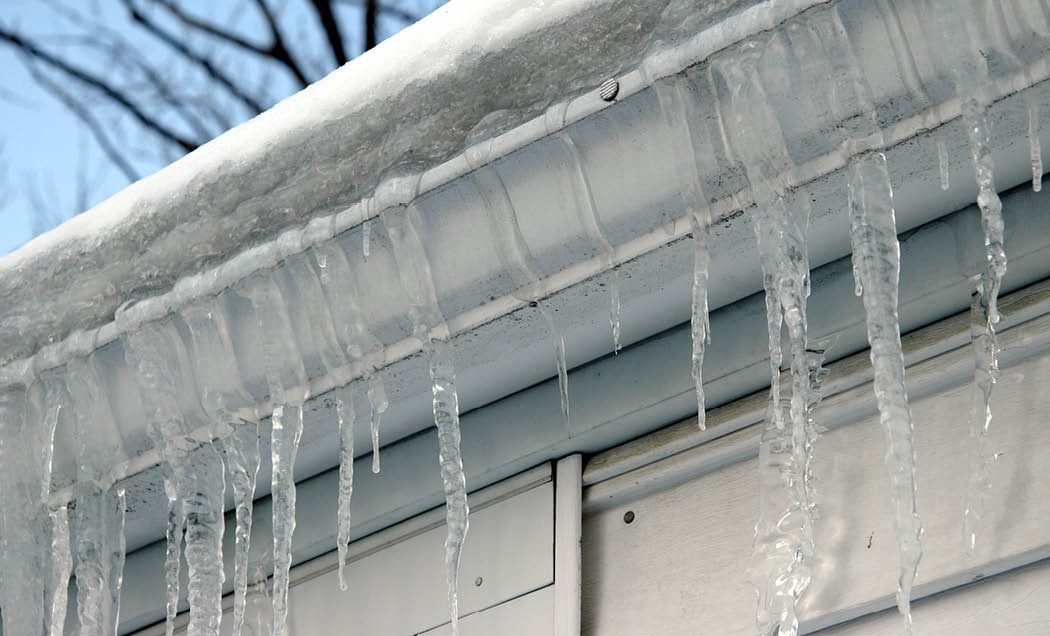Reduce ice dams with attic insulation
Here in Central Oregon, ice dams are a real problem. An ice dam is a ridge of ice that forms at the edge of a roof and prevents melting snow (water) from draining off the roof. The water that backs up behind the dam can leak into the home, causing damage.
Ice dams cause cracked plaster ceilings and walls, peeling paint, soaked carpets, and buckled wood floors. You may also see soggy insulation, rotting joists, and mold growth. Most commonly, ice dams collapse rain gutters.
Here we review the basics on ice dams, including:
What causes ice dams?
Ice dams develop after a heavy snowfall when warm air in the attic causes the roof to warm and the snow to melt. Water running down the roof refreezes when it reaches the colder roof edge, forming a mound of ice. The ice traps meltwater, which can seep back up under shingles and drip through the roof into your house, causing all kinds of damage.
How do you reduce ice dams?
The key to reducing ice dams is to keep your attic and roof cold. After a snowfall, a cold roof will have a thick blanket of snow. A warmer roof is likely to have a significant number of icicles hanging from the eaves. Below, you’ll find our best advice for keeping your roof cold.
It’s worth reflecting that you could still get ice dams even if you follow the advice in this article. In the same way, a person could still get heart disease even if they follow their doctor’s advice to eat a healthy diet. Our bodies, just like our homes, are complex systems. To talk about additional options to reduce ice dams, please give us a call in Bend, Oregon at 541.330.8767.
Insulate your attic and seal air leaks.
When you look in your attic, you should see more than a foot of blown-in insulation on the attic floor. We typically use loose fiberglass insulation for attics in Central Oregon. If you have a problem with ice dams and see little or inconsistent insulation in your attic, then attic insulation should top your priority list. Learn more about installing insulation in Bend, Oregon.
Before adding attic insulation, it’s critical to find and seal gaps that let air from your home into your attic and vice versa. The most common areas for air leaks include:
Behind and under kneewalls
Dropped soffits that are open to the attic
Attic hatch
Wiring holes
Holes for plumbing and pipes
Recessed lights
Furnace flue or duct chaseway (the hollow box or wall feature that hides ducts)
Ducts should be sealed and insulated; exhaust air should be vented outdoors.
The ducts in your attic have a big impact on ice dams. For example, we often find leaky, uninsulated furnace ducts running through attic spaces. If the heated air from your furnace gets into your attic, it will warm the roof and contribute significantly to ice dams.
We also find bathroom and kitchen fans that vent air into attics rather than outdoors. Remember that preventing ice dams is all about keeping your roof cold. Your roof will warm and cool every time you take a shower if the vent from your bath fan sends the warm, moist air from your bathroom into your attic.
The takeaway here - your ducts should be sealed and insulated to prevent leakage and condensation; bathroom and kitchen fans should vent air outdoors. All of this contributes to a clear separation between the warm, conditioned air in the living space of your home and the cold air in your attic and on the surface of your roof.
Make sure you have enough attic ventilation.
Attic ventilation draws in cold outdoor air and flushes out warmer attic air, cooling the attic and the roof in the process. A ridge vent paired with continuous soffit vents circulates cold air under the entire roof. Both ridge and soffit vents should have the same size openings and provide at least 1 square foot of opening for every 300 square feet of attic floor. Place baffles at the eaves to maintain a clear path for the airflow from the soffit vents.
For an inspection of the air sealing, insulation, ducts, vents, and ventilation in your attic, please give us a call in Bend at 541.330.8767 or schedule a consultation online:
What should you do if you have ice dams now?
As a first step, rake the snow off your roof after a heavy snowfall. We recommend using a long-handled aluminum roof rake while you stand safely on the ground. If you pull the snow down, it can’t melt and form an ice dam. It’s an effective, if tedious, solution, but only for single-story homes. Never use a snow rake when standing on a ladder, and take care not to break the shingles, which become more brittle in cold weather.
If you have leakage from an ice dam and can’t rake the snow off your roof, your best bet is to hire a roofing company to steam it off. A steamer is like a pressure washer, except that the water is hot. It melts the ice away without damaging the roofing. Chipping the ice off with a hatchet or an ice pick could break or puncture the shingles. Here in Central Oregon, we recommend McMurray and Sons Roofing. You can reach them at 541.385.0695.

